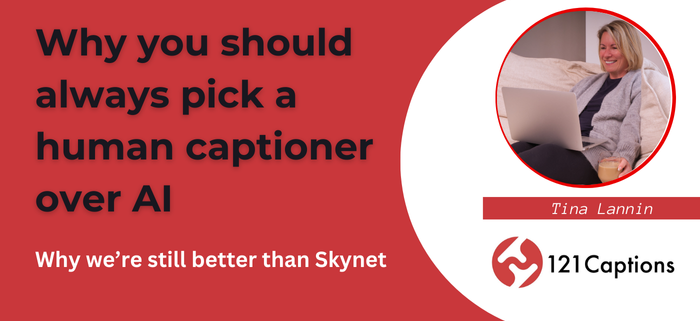Why you should always pick a human captioner over AI
In the age of AI-powered technologies, the transcription and captioning industry has seen remarkable transformations. AI systems now offer quick and cost-effective captioning solutions, making them tempting options for businesses and individuals alike. However, when it comes to ensuring high-quality, accurate and legally compliant captions, human captioners remain the superior choice. Here’s why you should always pick a human captioner over AI.
Accuracy that AI cannot match
AI captioning has come a long way, but it still lacks the nuanced understanding that only a human can provide. Human captioners are trained to recognise context, sarcasm, idioms and non-verbal cues like laughter, applause, or music – all elements that AI often misses. This makes human captioning far more reliable, especially for complex content like legal proceedings, educational material or technical jargon.
AI systems might struggle with heavy accents, dialects, or multiple speakers, and they can produce jumbled text in these scenarios. By contrast, a human captioner can discern between speakers and capture the essence of what is being communicated, ensuring that the captions are clear, contextually accurate and easy to follow.
Legal compliance and quality standards
For industries subject to strict regulatory requirements – such as broadcasting, education, and public service – captions must adhere to certain legal standards, such as those set by the FCC in the United States. These standards often require captions to reflect not just the spoken word but also background sounds and environmental cues that AI systems might ignore.
Human-generated captions excel in meeting these standards, ensuring that all viewers, particularly those with hearing disabilities, receive a comprehensive and meaningful viewing experience. Inaccurate captions can lead to legal risks and fines for failing to comply with these regulations. Human captioners guarantee the level of quality and detail that AI systems are not yet capable of achieving.
Personalisation and adaptability
One of the greatest advantages of human captioners is their ability to adapt to the unique needs of each project. Human captioners can provide tailored solutions, whether it’s adapting to specific industry jargon, incorporating real-time feedback, or adjusting to the preferences of the audience.
For example, captions created for live events require an understanding of timing, tone, and pace, factors that human captioners can intuitively manage. AI, while fast, cannot account for these subtleties and often produces robotic, contextually flat captions that don’t offer the rich experience human captioners deliver.
Handling complex, real-time situations
For live events, human captioners are indispensable. Real-time captioning (CART) requires not only speed but an acute attention to detail that AI simply cannot replicate. Human captioners deliver captions word by word, making it easier for viewers to stay engaged and understand what is happening in the moment. Many AI solutions, on the other hand, output captions in delayed blocks, which can lead to confusion and a lack of engagement.
In live settings, such as business conferences, lectures, or webinars, a human captioner can quickly adapt to unexpected changes, from speaker switches to audience interactions, ensuring smooth, seamless communication. AI captioning systems, while quick, lack the agility to keep up with these dynamic environments.
The human touch: Deaf awareness and inclusivity
At 121 Captions, our human captioners are not just transcription experts, they are also trained in deaf awareness, which means they understand the specific needs of deaf and hard-of-hearing individuals. This level of awareness allows human captioners to create captions that are truly inclusive and accessible to all viewers, ensuring that nothing is lost in translation.
AI systems, no matter how advanced, cannot replicate the care and attention to detail that comes with this human touch. The ability to understand deaf voices, differentiate between different speakers, and capture nuances like tone and body language is what makes human captioning far more effective in creating an inclusive environment.
Why human captioning is still the gold standard
While AI captioning offers speed and affordability, it falls short in areas where accuracy, context and legal compliance matter most.
Human captioners are irreplaceable when it comes to delivering high-quality, nuanced, and reliable captions that serve a diverse audience, particularly those with hearing impairments. The choice between human and AI captioning isn’t just about speed or cost; it’s about ensuring that your content is accessible, accurate and meaningful for all viewers.
If you value precision, legal compliance and inclusivity, then human captioning is the best choice. At 121 Captions, we take pride in providing top-tier, real-time captioning services backed by years of experience and a deep understanding of the unique needs of our clients.
Contact us today to learn more about why our human captioners are the best in the business and how we can help you deliver flawless captions for your content.




Leave a Reply
Want to join the discussion?Feel free to contribute!